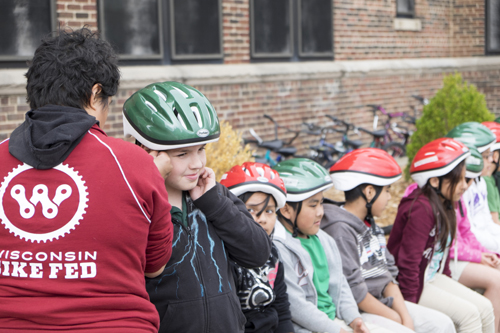Safe Routes a Cycling Necessity

This photo, taken at the time kids would be biking home from school, shows the narrow sidewalk that is the only “safe” route for a quarter of the kids attending Middleton schools. City officials, police and the transportation department say taking a sidewalk like this is the only option and nothing will be changed until at least 2019. “I know children who are terrified of biking down this stretch of sidewalk even though they have good cycling skills,” article author Kierstin Kloeckner said. “Most parents won’t even allow there kids to bike this section even with adults. This is also my route to work.”
Cycling with Kierstin Kloeckner
I remember a time, thirty-five years ago, when children routinely walked or biked to school. I was seven then, and it was this simple task, of walking to or from school alone or with friends, that shaped my entire life and made me the independent and strong woman I am today.
Maybe you think I’m oversimplifying this. Maybe you think my mom was negligent. Maybe you live in a community where you’d never feel comfortable allowing your children to walk or bike to school. But let me tell you what walking to and from school did for me as a young girl, and biking or inline skating did for me as I got older. First, it gave me time alone. It allowed me to feel comfortable in a big world, as a small girl. It also gave me problem-solving skills. I distinctly remember several days when I’d either allow myself to daydream and go off course, or my friends and I would want to “explore” and we’d lose our bearings.
Was there a moment or two of panic? Sure! But this is what taught me to think critically – this, I believe, more than anything else I experienced as a child. We would backtrack our route or think “well, we went this way two blocks off our route which means we have to go this way two blocks to get back on route.” This experience also made me become closer to nature and my surroundings. I would walk home on rainy days and pick up worms (hundreds of them) off the sidewalk thinking I was saving them. I would listen to birdsongs and try to guess which bird sang them. I would pet every dog and cat in the neighborhood. Lastly, it gave me exercise, even though I never thought of it as exercise. This forward propulsion either by bike or walking got me from point A to point B while burning not only calories but also anxiety, stress, pent-up energy, all while I built my self-esteem. The beautiful thing is, none of this was structured. This was my time, and looking back, I wouldn’t have traded it for the world. Sure, there were times I would whine about having to walk a mile to high school in the cold Minnesota winters, but rarely did I ever wish I hadn’t by the time I got to school.
Fast forward thirty five years. As a non-parent, I am aghast at the lines of idling cars outside of schools. I am sickened by the fact so many parents in my neighborhood don’t feel safe having their children walk one-two miles from school even in pleasant weather, and as a personal trainer, I am saddened by the rising rate of childhood obesity due to lack of daily movement. We, as citizens, politicians, urban planners and parents are making not only a sick generation but also a generation lacking in critical thinking. The numbers don’t lie. Thirty years ago, 66% of all children biked or walked to school. Today, less than 13% do. This, I would say, is an enormous problem. A problem I am fighting tooth and nail right now in my own community.
You see, I live in this “island” of sorts inside a city which deems itself “bike friendly.” Currently, in the city of Middleton, Wis. (the suburb just west of platinum-bike-rated Madison), there are several large pockets with no safe routes for children/adults to either walk or bike to school or work. Every parent I’ve spoken with – and most of these parents are avid cyclists themselves – swear that until the city works on safe bike paths or bike lanes, along with safe crossings over a road where people routinely travel 45+ miles per hour (in a 30-35 mph zone), they will only allow their kids to bus or be driven to school. Although the city agrees with this need, nothing will be done until at least the summer of 2019. That means we are losing one more generation of kids who will have walking or biking instilled in them as a viable form of transportation. One more generation of kids who may face inactivity or obesity, and one more generation of kids who may not know how to travel 1.5 miles to get from home to school.
Thankfully, not all is lost. Ten years ago, a non-profit organization was formed called Safe Routes to School. It’s simple, yet elegant, mission and vision being: “Advance safe walking and bicycling to and from schools, to improve the health and wellbeing of kids of all races, income levels and abilities and to foster the creation of healthy communities for everyone.” And the National Partnership for Safe Routes to School is a catalyst for the creation of safe, active, equitable and healthy communities – urban, suburban and rural – throughout the United States. A few years ago, Milwaukee, Wis., was awarded grant funds to apply this mission and vision under the Bicycle Federation of Wisconsin. Since then, the Bicycle Federation of Wisconsin has done so much for communities around the state to make positive changes.
Proper helmet fit is stressed in a Safe Routes to School event in Greenfield, Wis.
Dave Schlabowske/Wis. Bike Fed photo
Here is a sampling of their accomplishments:
The Bike Fed has educated more than 10,000 students through the Safe Routes to School programming in communities across Wisconsin, including Madison, Milwaukee, Kenosha, Union Grove, Appleton, Sturgeon Bay, Oregon, Waterford, Marshall, Sheboygan and West Allis. Safe Routes to School is a federally funded program to increase the number and safety of kids walking and biking to school through “the five E’s” of traffic safety: education, engineering, encouragement, enforcement and evaluation.
Benefits of Safe Routes to School programs include:
• Increasing students’ levels of physical activity, leading to improved health;
• Lowering the number of parents driving their children to school, leading to less traffic congestion around schools;
• Improving air quality surrounding schools and reducing automobile emissions;
• Giving children an early start in understanding traffic rules, preparing them to become responsible motorists later in life;
• Helping students develop a sense of responsibility as they understand the importance of following traffic rules.
A Wis. Bicycle Federation rep teaches kids bike safety at Greenfield Bilingual School.
Dave Schlabowske/Wis. Bike Fed photo
I asked Jake Newborn, the youth education manager at the Wisconsin Bicycle Federation, what some of the changes he has seen since starting the program in Milwaukee and where he’d like to see the program go. He mentioned schools having to purchase more bike racks because so many kids had started biking regularly to school, a third-grade student he knew began walking daily to school because they were inspired by the program and a group of fourth- and fifth-graders are proposing a law to make cycling the official state exercise. What Jake really wants to see, however, is more parent involvement. As much as they have done to directly educate 18,000 Milwaukee students, the parents make the final decision on travel habits and many parents fear their children dealing with motor vehicle traffic.
The Safe Routes to School program not only offers training in the community, but also bike camps and a free downloadable curriculum for anyone to use. Other Midwestern states have followed suit. Michigan, Minnesota, Illinois and Iowa have all started using the national curriculum in programs of their own. I’ve personally seen trained instructors pull up to schools to teach parents, children and teachers how to use their information. “Give a man a fish and you feed him for a day; teach a man to fish and you feed him for a lifetime” is the only thing I can think of when I see these programs at work.
Using proper hand signals was part of the curriculum in this Safe Routes to School exercise.
Dave Schlabowske/Wis. Bike Fed photo
Programs like this can not only change a child’s life and help form their future, but also change a community, a city, a state and our nation. If we work together, and adopt programs like Safe Routes to School in every community, our physical, mental and social health achievements are limitless.
In my Utopian world, I would love to see even the smallest communities think about how they can better their infrastructure to safely transport children and adults to their daily destinations. I understand how difficult this can be in rural communities, which make up most of the Midwest, but even the simplest steps, such as parents leading bike trains to elementary schools, creative thought put into intersection crossings or the city/townships placing “may use full lane” signs to show people cyclists are not only allowed but welcomed can go such a long way without much expense. We can do this if we work together!





